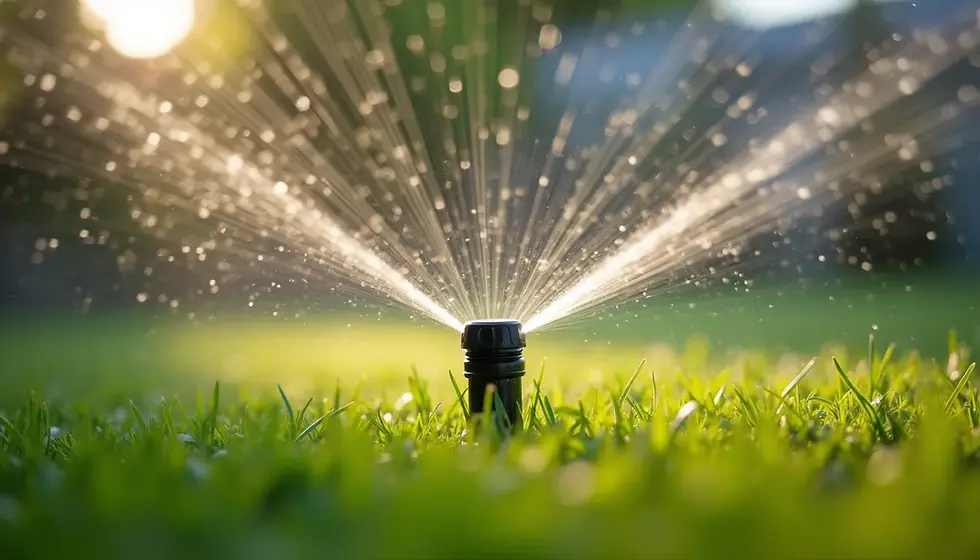How long should sprinklers run in each zone? A no-math scheduling guide 💧
- Mei-Lin Arora

- Sep 6
- 4 min read
Updated: Sep 7
Getting watering right saves grass, shrubs, and your water bill. So, how long should sprinklers run in each zone? The honest answer: it depends on your sprinkler head type, precipitation rate, soil, slope, and plants—but you can dial it in quickly with a simple test and a smart weekly plan.
Pro tip: Schedule by zone, not the whole yard. Rotors, sprays, and drip put out water at very different rates—one time fits none. Pro tip: Use cycle-and-soak on clay or slopes (e.g., 2–3 shorter cycles) to avoid runoff and still hit your target depth. 🌱

How long should sprinklers run in each zone (the fast, accurate method)
Find your target depth. Most cool-season lawns thrive on about 1 inch of water/week in hot weather (less in spring/fall), while shrubs often need ½–1 inch/week depending on species. See the science-backed basics at the EPA WaterSense outdoors page.
Measure your zone’s output (catch-can test).
Set 6–8 identical cups in one zone.
Run the zone 10 minutes.
Average the water depth in the cups.
Do the math: if you got 0.25", you need ~40 minutes total that week to reach 1". Split across days with cycle-and-soak as needed.
Reality check: Asking “how long should each sprinkler zone run” or “how long should sprinklers run per zone” without testing is guesswork. Ten minutes of measuring beats months of trial and error.

Quick starting points by head type (then fine-tune)
Use these as first drafts—then confirm with the test above.
Fixed sprays (high output): ~8–12 min per cycle to deliver ~¼" (often 2–3 cycles per watering day).
Gear rotors (medium output): ~20–40 min per cycle for ~¼" (1–2 cycles).
Rotary nozzles/MP rotators (low output): ~35–60 min per cycle for ~¼" (1–2 cycles).
Drip for beds: Water by hours and emitters (target soil moisture, not inches).
How to use those numbers week to week
Split the weekly total. In heat, apply your weekly need over 2–3 days (e.g., 0.5" + 0.5").
Adjust for season. Spring/fall often need 30–50% less; use your controller’s seasonal adjust.
Mind the soil. Clay = shorter cycles; sandy = longer but less total water.
Plants ≠ lawn. Shrub and tree zones usually need less frequent, deeper watering than turf.
FAQ-style phrasing helps the algorithm and the human: “How long should I run sprinklers per zone? Long enough to deliver the measured weekly depth for that zone—confirmed with a catch-can test.”

Troubleshooting common questions (and phrasing variants)
“How long should a sprinkler zone run” if I see runoff?Cut the runtime in half and add a second cycle 30–60 minutes later. That’s cycle-and-soak.
“How long to run each sprinkler zone” if my smart controller guesses wrong?Keep the smart features, but calibrate the precipitation rate using your cup test; enter the real in/hr so suggestions match reality.
Uneven green?You may have poor head-to-head coverage or clogged nozzles. Fix uniformity first; time alone won’t solve dry crescents.
Sample weekly plan (putting it together)
Let’s say your rotor front lawn measured 0.25" in 25 minutes. You want 1" per week in summer.
Run 25 min × 4 total across the week (e.g., Tue/Thu: two 12–13 min cycles each day).
Your spray backyard measured 0.25" in 10 minutes. Run 10 min × 4 (split into 5 + 5) across the same days.
Shrub drip runs 45–90 min once or twice weekly—check soil 3–4" down; it should be damp, not soupy.
For controller setup best practices and water-saving ideas, the EPA WaterSense and extension links above are trustworthy, long-standing references.
FAQ
In one sentence: how long should sprinklers run in each zone?
Long enough to deliver your weekly target (often ~1") as measured by a catch-can test—then split into cycle-and-soak to prevent runoff.
How often should I water?
Usually 2–3 days/week in hot weather; reduce with cooler temps or rain.
What if heads differ in one zone?
Avoid mixing head types in a zone; if you must, set time by the slowest head and tune others with nozzle changes.
Do smart controllers replace testing?
They help, but accurate precip rates and zone plant types still need your input.
Conclusion
To answer how long should sprinklers run in each zone, stop guessing and measure. Use the cup test to set a weekly total, then schedule cycle-and-soak by head type so each area gets what it needs without waste. Whether you ask “how long should each sprinkler zone run,” “how long should sprinklers run per zone,” “how long should I run sprinklers per zone,” “how long should a sprinkler zone run,” or “how long to run each sprinkler zone,” the method above makes your lawn greener and your watering bill lighter. 🙂



Comments